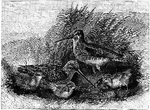
Family of Snipes
"Gallinago wilsoni. American Snipe. Wilson's Snipe. "English" Snipe. Jack-Snipe. Crown black, with a…
Red-breasted Snipe Head
"Macrorhamphus griseus. Red-breasted Snipe. Gray Snipe. Brown-back. Dowitcher. In summer:Under parts…
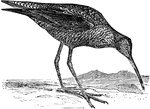
Stilt Sandpiper
"Micropalama himantopus. Stilt Sandpiper. In summer: blackish, each feather edged and tipped with white…
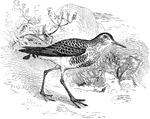
Sanderling
"Calidris arenaria. Sanderling. Ruddy "Plover". Adult in summer: Entire upper parts and neck all round…
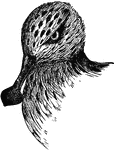
Spoon-billed Sandpiper
"Eurynorhynchus pygmaeus. Spoon-billed Sandpiper. General appearance of a stint, and size little greater.…
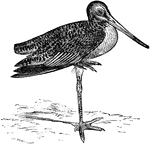
Marbled Godwit
"Limosa fedoa. Great Marbled Godwit. Marlin. Feathers not extending on side of lower mandible to a point…

Willet Head
"Symphemia semipalmata. Semipalmated Tattler. Willet. Adult in summer: Upper parts ashy, confoundedly…
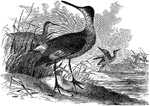
Willets
"Symphemia semipalmata. Semipalmated Tattler. Willet. Adult in summer: Upper parts ashy, confoundedly…

Greater Yello-shanks
"Totanus melanoleucus. Greater Tell-tale. Greater Yellow-shanks. Long-legged Tattler. Stone-snipe. Bill…

Solitary Sandpiper
"Rhyacophilus solitarius. Solitary Tattler. American Green Sandpiper. Solitary Sandpiper. Above, dark…

Spotted Sandpiper
"Tringoides macularius. Spotted Sandpiper. Above, silken ashen-olive (quaker-color- as in our cuckoos)…
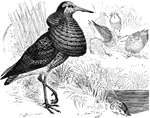
Ruff
"Machetes pugnax. Ruff. Reeve. Combatant. Gambetta. Varied above with black, brown, buff and chestnut,…

Buff-breasted Sandpiper
"Tryngites rufescens. Buff-breasted Sandpiper. Above, brownish-black with a greenish gloss, every feather…
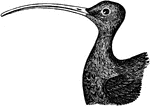
long-billed Curlew
"Numenius longirostris. Long-billed Curlew. Sickle-bill. Plumage very similar to that of the Godwit,…
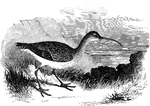
Hudsonian Curlew
"Numenius hudsonicus. Hudsonian Curlew Jack Curlew. General tone of coloration scarcely rufous, the…
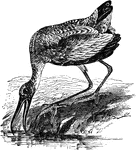
Wood Ibis
"Tantalops loculator. American Wood Stork. Wood Ibis. Colorado Turkey. Plumage white, the wing-quills,…
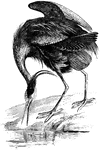
Great Blue Heron
"Ardea herodias. Great Blue Heron. Of large size, and varied dark colors, not dichromatic. Back without…
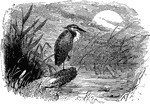
Night Heron
"Nyctiardea grisea naevia. Black-crowned Night Heron. Qua-bird. Squawk. Crown, scapulars and interscapulars…
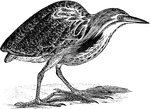
American Bittern
"Botaurus mugitans. American Bittern. Indian Hen. Stake-driver. Bog-Bull. Plumage of the upper parts…
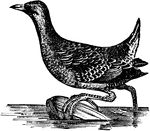
Small Carolina Rail
"Porzana carolina. Carolina Crake. Common Rail. "ortolan." Above, olive-brown, varied with black, with…
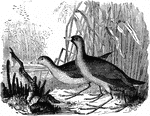
Carolina Rail
"Porzana carolina. Carolina Crake. Common Rail. "ortolan." Above, olive-brown, varied with black, with…
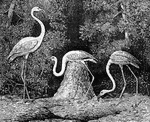
American Flamingo
"Phoinikopteros ruber. American Red Flamingo. Adult: Plumage scarlet, the primaries and most of the…
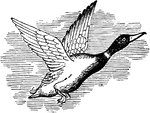
Wild Duck
"Anus boscas. Mallard. Wild or Domestic Duck. Green-head. Bill greenish-yellow. Feet orange-red. Iris…
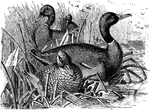
Mallards
"Anus boscas. Mallard. Wild or Domestic Duck. Green-head. Bill greenish-yellow. Feet orange-red. Iris…
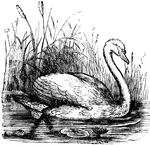
Mute Swan
"Cygynus. White Swans. Neck of extreme length. Trachea normally entering sternum. Bill tuberculate or…
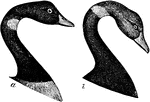
Black Brant Head
"Bernicla nigricans. Black Brant. Bill, feet, and claws black; iris brown. Head and neck all around,…
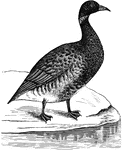
Black Brant
"Bernicla nigricans. Black Brant. Bill, feet, and claws black; iris brown. Head and neck all around,…
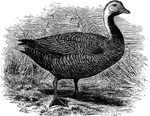
Emperor Goose
"Philacte canagica. Painted Goose. Emperor Goose. Wavy bluish-gray, with lavender or lilac tinting,…
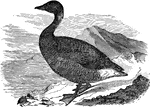
Common Brant
"Bernicla brenta. Brant Goose. Bill, feet, and claws black; iris brown. Head and neck all around, and…
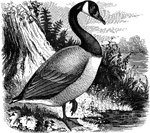
Canada Goose
"Bernicla canadensis. Canada Goose. Common Wild Goose. Tail normally 18-feathered. Bill, feet, head,…
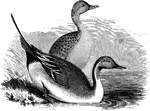
Pin-tail Ducks
"Dafila acuta. Pin-tail Duck. Sprig-tail. Bill black, with grayish-blue edge of upper mandible; feet…

American Wigeon
"Mareca americana. American Wigeon. Bald-pate. Bill grayish-blue, with black tip and extreme base; feet…
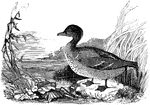
American Green-winged Teal
"Querquedula (N.) carolinensis. American Green-winged Teal. Bill black; feet bluish-gray: iris brown.…
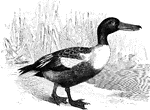
Northern Shoveler
"Spatula clypeata. Shoveller Duck. Broad-bill. Bill blackish; iris orange-red: feet vermilion-red. Head…
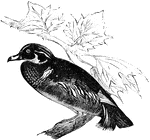
Wood Duck
"Aix sponsa. Wood Duck. Summer Duck. "The Bride." Adult Male: Bill pinkish-white, with lake-red base,…
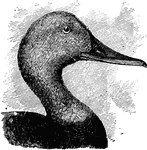
Canvas-back Head
"Fuligula vallisneria. Canvas-back. Adult male: The head close-feathered. Bill high at the base and…
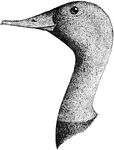
Large Canvas-backs Head
"Fuligula vallisneria. Canvas-back. Adult male: The head close-feathered. Bill high at the base and…
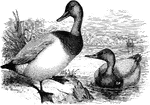
Canvas-backs
"Fuligula vallisneria. Canvas-back. Adult male: The head close-feathered. Bill high at the base and…
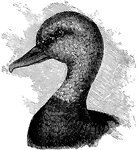
Small Redhead
"Fuligula ferina americana. Red-head. American Pochard. The feathers of the head somewhat full and puffy,…

Large Redhead
"Fuligula ferina americana. Red-head. American Pochard. The feathers of the head somewhat full and puffy,…
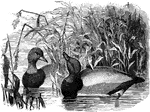
Redheads
"Fuligula ferina americana. Red-head. American Pochard. The feathers of the head somewhat full and puffy,…

Buffleheads
"Clangula albeola. Buffle-head. Butter-ball. spirit-duck. Dipper. Bill with nostrils rather behind than…
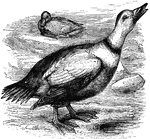
Labrador Duck
"Camptolaemus labradorius. Labrador Duck. Pied Duck. Adult male: Bill black with orange at base and…

The Bill of an Eider
"Somateri mollissima. Somateri dresseri. Common Eider. Bill gibbous at base of upper mandible; outline…
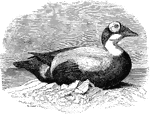
Spectacled Eider
"Somateria fischeri. Spectacled Eider. Bill (in both sexes) peculiar in the extension upon it of dense…
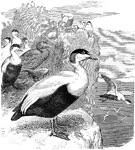
Eider Ducks
"Somateria mollissima. European Eider Duck. Bill with lateral frontal process extending on each side…

Black Scoter
"Oidemia americana. American Black Scoter. Sea Coot. Adult male: Plumage entirely black, less glossy…

Surf Duck
"Oidemia perspicillata. Surf Duck. Sea Coot. Adult male: Bill as above, singularly variegated in color,…
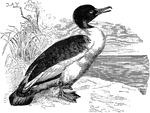
Merganser
"Mergus merganser. Merganser. Goosander. Nostrils near middle of bill. Frontal feathers extending acutely…

Red-breasted Merganser
"Mergus serrator. Red-breasted Merganser. Nostrils near base of bill. Frontal feathers extending obtusely…

Red-faced Cormorant and Nest
"Phalacrocorax bicristatus. Red-Faced Cormorant. Frontal feathers not reaching base of the culmen, the…

Double-crested Cormorant
"Phalacrocorax dilophus. Double-crested Cormorant. Tail of 12 feathers. Gular sac convex behind. No…
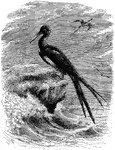
Frigate Birds
"Tachypetes aquilus. Frigate. Man-of-War Bird. brownish-black, glossed with green of purplish, duller…

Frigatebird Head
"Tachypetes aquilus. Frigate. Man-of-War Bird. brownish-black, glossed with green of purplish, duller…

White-headed Gull Head
"Larus heermanni. White-headed Gull. Bill shorter than head or tarsus, rather slender, moderately compressed,…

Laughing Gull Bill
"Chroicocephalus atricilla. Laughing Gull. Black-headed Gull. Bill longer than middle toe and claw,…
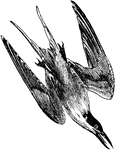
Roseate Tern
"Sterna dougalli. Roseate Tern. Paradise Tern. Bill about as long as head or foot, straight, slender,…
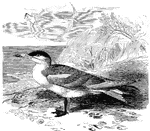
Caspian Tern
"Sterna (T.) caspia. Caspian Tern. Imperial Tern. Bill dark vermilion red, growing and somewhat "diaphanous"…

Royal Tern
"Sterna (T.) maxima. Cayenne Tern. Royal Tern. Adult in summer: Pileum glossy greenish-black, not extending…
Elegant Tern
"Sterna (T.) elegans. Elegant Tern. Princely Tern. Bill bright red, salmon-colored toward tip. Feet…